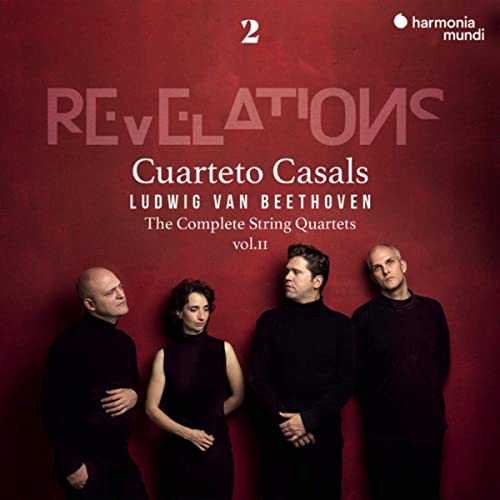
Composer: Ludwig van Beethoven
Performer: Cuarteto Casals
Audio CD
Number of Discs: 1
Format: FLAC (tracks)
Label: Harmonia Mundi
Size: 1.16 GB
Recovery: +3%
Scan: yes
01. String Quartet No. 8 in E Minor, Op. 59, No. 2: I. Allegro
02. String Quartet No. 8 in E Minor, Op. 59, No. 2: II. Molto adagio. Si tratta questo pezzo con molto di sentimento
03. String Quartet No. 8 in E Minor, Op. 59, No. 2: III. Allegretto – Maggiore, Thème russe
04. String Quartet No. 8 in E Minor, Op. 59, No. 2: IV. Finale. Presto
05. String Quartet No. 9 in C Major, Op. 59, No. 3: I. Introduzione. Andante con moto – Allegro vivace
06. String Quartet No. 9 in C Major, Op. 59, No. 3: II. Andante con moto quasi allegretto
07. String Quartet No. 9 in C Major, Op. 59, No. 3: III. Minuetto. Grazioso – Trio
08. String Quartet No. 9 in C Major, Op. 59, No. 3: IV. Allegro molto
After “Inventions”, “Revelations” is the second volume in a complete set of the Beethoven quartets that breaks new ground: it aims to regroup the works according to their position within the three broad creative divisions of the composers life the formative years, the heroic period and the late period. This programme assembles the median quartets, in other words the works that prolonged and consolidated the stylistic innovations outlined at the beginning of each of these creative periods. © harmonia mundi
Extraordinary!
Of all my review assignments for the present issue, I set this one aside and saved it for last. Why? Because after listening to it all the way through twice and then relistening to individual movements, I honestly didn’t know if I’d be able to find the words to convince you, the reader, that unless and until you hear the Cuarteto Casals perform these Beethoven quartets, you have never heard these Beethoven quartets. I thought I had heard and knew them all inside out from the dozens of recordings I have and from the countless live performances I’ve attended. But the Cuarteto Casals dives deeper into the depths of this music and brings even more of its secrets to the surface than I could have imagined possible.
This is only my second encounter with this exceptional, 1996-founded, Spanish ensemble—I reviewed the group’s set of Mozart’s early string quartets for Harmonia Mundi with much enthusiasm in 29:6—but its discography is considerably larger than its few entries in the Fanfare Archive would suggest, ranging from A to Z (Arriaga to Zemlinsky). In fact, the three-disc set of Beethoven quartets currently before me is labeled Volume II, but I find no evidence that Volume I was ever received here for review.
For the record, Volume 1 contains the Quartets Nos. 1, 3, and 4 of the op. 18 set; No. 7, op. 59/1, of the “Razoumovsky” set; Nos. 12 and 16, opp. 127 and 135; and the arrangement for string quartet of the Piano Sonata No. 9, op. 14/1. With this Volume 2 of the cycle, the Cuarteto Casals has covered 11 of the 16 quartets, so one more three-disc set should do it. Mixing quartets from Beethoven’s early, middle, and late periods is not the usual way ensembles record their surveys of these crucial works, but it does have one advantage. It enables us to judge if and how players adapt their methods of execution and interpretive approaches, when works from different moments in history and a composer’s career are heard in close juxtaposition.
I will admit that listening to the Cuarteto Casals play these quartets forced me to forsake long-held prejudices against those who take liberties with the score, and it must be acknowledged that the ensemble’s players do take liberties. But those liberties do not rise to accusations of self-indulgence or willful interventions. Rather, they involve practices such as the subtle weighting of a note in a phrase, modulation of vibrato, allowing passing prominence to a voice at a point where it’s usually subordinate, and articulating a phrase in such a way that its expected breath or break point is shifted. It’s these small alterations that reveal aspects of the music in different and surprising ways. Let me give some examples.
Listen to the very first bar of the “Harp” Quartet, op. 74, and hear how the players stealthily shape the four notes that covertly conceal within them the four-note motive that informs and infiltrates the entire movement. And then in bar eight, listen to how first violinist Vera Martínez Mehner leans into the quarter-note B on the first beat, falling a step to A, and then the A on the third beat, falling a half-step to G. You could argue, “Well, there’s no accent mark there, no indication of a crescendo, so why?” But it’s a “tell,” and it shares a secret with us that’s revealed four bars later, where the pattern is mirrored, first on a G falling a whole-step to F in bar 12, and then in bar 13, on an A falling a half-step to G.
These are the subliminal signals Beethoven sends us—messages telegraphed in mere gestures, music’s body-language, if you will—that are the secret of his communicative power, and the Cuarteto Casals gets it. Just within the first few bars, the players lay out for us how this story will unfold and how it will end. But spoiler-alert notwithstanding, they create such expectancy that it’s a story we’re compelled to hear in its entirety for ourselves. It’s no mere affectation that the three-disc set is titled Revelations.
Another notable example is the cello pizzicatos in the second movement of the C-Major Quartet, op. 59/3. Each time, on the last note of the two bars of eighth-notes—first ending, bar 6, D; second ending, bar 8, D—cellist Arnau Tomàs Realp hesitates for an almost imperceptible nanosecond before plucking the downbeats to the next bars. It’s oh so understated, yet it’s just enough to convey a sense of tentativeness in the footstep, as if to ask, should I press on into this “ancient and starless night of the soul”—J. W. N. Sullivan. But it’s not unique to the cello. On the last beat of bar 11, the first violinist echoes the idea by holding on to her F by the tiniest fraction of a beat in order to heighten the pathos of its fall by a half-step to E on the downbeat of bar 12. Violist Jonathan Brown picks up on the cue after the repeated double bars at measure 28, where on the third beat, his C to D, marked by a sudden f, comes as a shocking stab in the heart. This isn’t just musicians perfectly executing notes on a page, though there’s certainly that. It’s musicians in harmonic vibration with each other, just as the strings of their instruments are vibrating. They become one voice that penetrates to the very core of the music.
The madcap fugal finale of this quartet is jaw-dropping, not just for the speed it starts out at, but for the players’ ability to maintain that speed without flagging. My experience with this movement is that the violist, who jumps in first, often takes off at incredible breakneck speed. When the second violin enters in bar 11, the brakes start to be applied, though the slowdown is barely noticeable. By the time the first violin enters at bar 31, the notes are still whizzing by at the marked Allegro molto in cut time, but just a little less molto than they started out. They’ve now settled into a very fast tempo but one that’s not quite as frenetico. The amazing thing about the Cuarteto Casals’s players is that they don’t slow down at all, and they don’t sound in the least bit frantic. This should take care of any doubts anyone might have about the technical brilliance of this ensemble.
A final example I’ll give is that of the great Heiliger Dankgesang movement in the A-Minor Quartet, op. 132. The players produce a tone that glows from within and surrounds them like a halo. But it’s at the tempo changes from Molto adagio to Andante, the first time marked by Beethoven Neue Kraft fuhlend (New strength felt), that the players avoid the common impulse to burst forth in a shout of joy, instead observing a rapt, spiritual celebration of thanksgiving.
These are just a few examples that make the Cuarteto Casals’s readings of these quartets so special. I could go on for pages describing the glories of these performances. But this I can tell you: I thought, as you may have too, that there was nothing new to be said in Beethoven’s quartets, that it had all been said before. Well, I was wrong, and if you thought that, then so were you. If I had to choose only one set of Beethoven’s string quartets to live with for my remaining time on this planet, it would be this one by the Cuarteto Casals.



